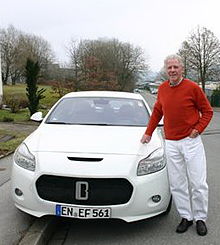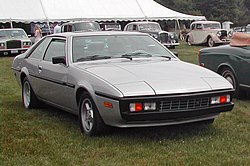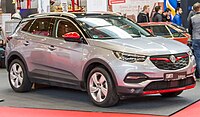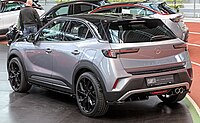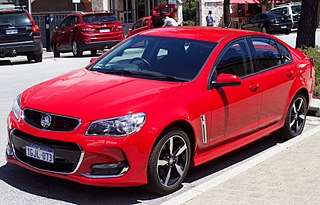
The Holden Commodore is a series of automobiles that were sold by former Australian manufacturer Holden from 1978 to 2020. They were manufactured from 1978 to 2017 in Australia and from 1979 to 1990 in New Zealand, with production of the locally manufactured versions in Australia ending on 20 October 2017.
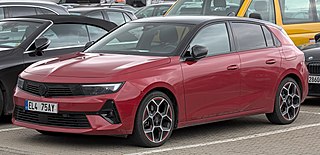
The Opel Astra is a compact car/small family car (C-segment) developed and produced by the German automaker Opel since 1991, currently at its sixth generation. It was first launched in September 1991 as a direct replacement to the Opel Kadett. As of 2022, the car slots between the smaller Corsa supermini and the larger Insignia large family car.
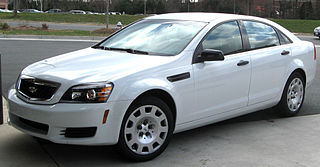
The Chevrolet Caprice is a full-size car produced by Chevrolet in North America for the 1965 to 1996 model years. Full-size Chevrolet sales peaked in 1965 with over a million sold. It was the most popular car in the U.S. in the 1960s and early 1970s, which, during its lifetime, included the Biscayne, Bel Air, and Impala.

The Opel Omega is a executive car engineered and manufactured by German automaker Opel between 1986 and 2004. The first generation, the Omega A (1986–1994), superseded the Opel Rekord. It was voted European Car of the Year for 1987, and was available as a saloon or estate. The second generation, the Omega B, was manufactured from 1994 to 2004.

The Holden Monaro is a car that was manufactured by General Motors' Australian division Holden. It has a front-engine, rear-wheel-drive layout and was produced with a two-door coupé body from 1968 to 1975 and again from 2001 to 2006 and with a 4-door sedan body from 1973 to 1977.

The Holden Torana is a mid-sized car that was manufactured by Holden from 1967 to 1980. The name apparently comes from a word meaning "to fly" in an unconfirmed Aboriginal Australian language. The original HB series Torana was released in 1967 and was a four-cylinder compact vehicle closely based on the British Vauxhall Viva HB series of 1966–1970.

The Buick Regal is a line of mid-size cars marketed by Buick since 1973. For nearly its entire production, the Regal has served as the premium mid-size/intermediate offering of the Buick product range. Introduced as a submodel of the Buick Century, the model line is currently in its sixth generation. From the 1970s to the 1990s, the Regal served as the Buick counterpart of the Pontiac Grand Prix and Oldsmobile Cutlass Supreme.

Zeta was the original name for General Motors' full-size rear-wheel drive automobile platform developed by GM's Australian subsidiary company Holden and was at one stage referred to as the "GM Global RWD Architecture". The GM Zeta platform replaced the V-body, and debuted with 2006 Holden Commodore (VE) sedan and Holden (VE) Ute. This platform was considered as the replacement for the North American W, H, and K platforms until plans were cancelled due to fuel-economy considerations and GM's financial situation. Although the future of the Zeta program was in doubt at that time, in May 2009, Holden began the development of an improved second version of the platform that went on to form the basis of the 2013 Commodore (VF) and Chevrolet SS.

The Opel Monza is an executive fastback coupe produced by the German automaker Opel from 1977 to 1986. It was marketed in the United Kingdom as the Vauxhall Royale Coupé by Vauxhall.

The Holden Caprice is a full-size car which was produced by Holden in Australia from 1990 to October 2017. The similar Holden Statesman, which was also introduced in 1990 as a model below the Caprice, was discontinued in September 2010. Between 1971 and 1984, Holden marketed their long-wheelbase sedans under the Statesman marque.

The Holden Kingswood is a full-size car that was developed and manufactured in Australia by Holden, from the beginning of the HK series in 1968 through to the conclusion of the WB series in 1985. Prior to 1968, the full-size Holden range of family cars comprised the Holden Standard, the Holden Special, and Holden Premier models. Initially, the HK range of models included the basic Holden Belmont, the Kingswood, and the luxury-oriented Holden Premier, all of which were manufactured in a choice of sedan and station wagon bodies. Commercial variants were offered in three types: coupé utility, panel van, and later from 1971, a heavy-duty Holden One Tonner cab chassis. The utility (ute) version was originally marketed in both Belmont and Kingswood configurations. However, after the Belmont name was deleted from commercials at the end of HQ in late 1974, the base model commercials were sold only with the "Holden" badge.

The Opel Diplomat is a luxury car manufactured by Opel from 1964 to 1977. Opel's top-ranging models were traditionally the Admiral and Kapitän, introduced in 1938 and 1937 respectively.
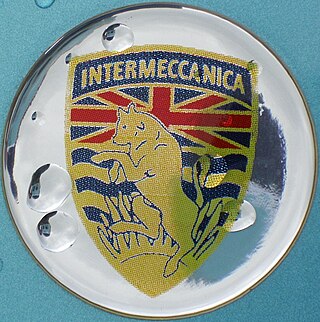
Intermeccanica is an automobile manufacturer, founded in Torino, Italy, in 1959 by Frank Reisner. It subsequently moved first to the United States, then to Canada, and is currently headed by Frank's son, Henry Reisner.

The Holden Commodore (VN) is a full-size car that was produced by Holden from 1988 to 1991. It was the first iteration of the second generation of this Australian made model, which was previously a mid-size car, as well as the first Commodore available as a coupé utility. The new range included the luxury variants, Holden Berlina (VN) and Holden Calais (VN) and, from 1990, introduced the commercial Holden Utility (VG).

The Holden was a full-sized car produced by the company of the same name across 5 generations from 1948 until 1984. The Holden is also commonly referred to by their model designation and also the H Series. The Holden was introduced to be Australia's car, being the first full scale produced automobile exclusive to the country. Prior to which, General Motors Holden's Ltd. assembled imported CKD kits from overseas General Motors subsidiaries such as Chevrolet, Buick, Vauxhall and more. And the only other cars built in the country being Ford and Chrysler vehicle bodies fitted to imported chassis. The Holden was an instant success among Australians, being the first production car built solely for Australia's unique, rough roads.
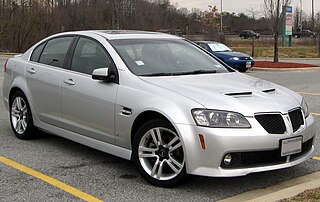
The Pontiac G8 is a full-size sedan which was produced by Holden in Australia for export to the United States, where it was sold by Pontiac. The G8, a rebadged Holden Commodore, was released in early 2008 for the 2008 model year in the United States, and in 2008 for the 2009 model year in Canada. Production stopped in mid-2009, following the GM decision to suspend the Pontiac brand. While available, the G8 took the place in the Pontiac lineup of both the Pontiac Bonneville, which ceased production after the 2005 model year, and the Pontiac Grand Prix, which ceased production after the 2008 model year.

The Holden Commodore (VT) is a full-size car that was produced by Holden from 1997 to 2000. It was the first iteration of the third generation of the Commodore and the last one to be powered by a locally made V8 engine (1998). Its range included the luxury variants, Holden Berlina (VT) and Holden Calais (VT) but not a new generation utility version.

The Holden Commodore (VS) is a full-size car which was produced by Holden from 1995 to 1997 and 2000 for utility versions. It was the fourth and final iteration of the second generation of the Commodore. The range included the luxury variants, Holden Berlina (VS) and Holden Calais (VS).

Statesman is an automotive marque created in 1971 by the Australian General Motors subsidiary, Holden. Statesman vehicles were sold through Holden dealerships, and were initially based on the mainstream Holden HQ station wagon platform, thereby providing more interior room and generally more luxurious features than their Holden-branded sedan siblings. Production ceased with the last of the WB series cars in January 1985.

The Opel Insignia is a large family car developed and produced by the German car manufacturer Opel from 2008 to 2022. Taking its name from a 2003 concept car, the model line serves as the flagship model, slotted above the Astra and Corsa in size. The Insignia serves as the successor to both the Signum and Vectra model lines, replacing both vehicles under a single nameplate. Currently in its second generation, the model line is offered in four-door sedan/saloon body styles, five-door liftback, and as a five-door station wagon/estate.
